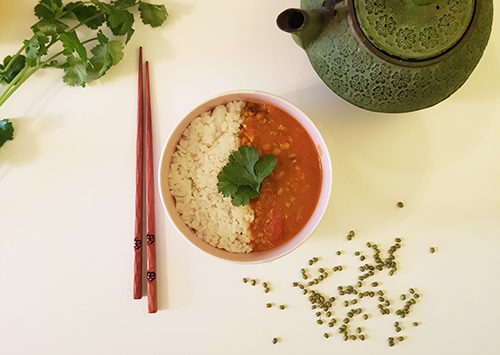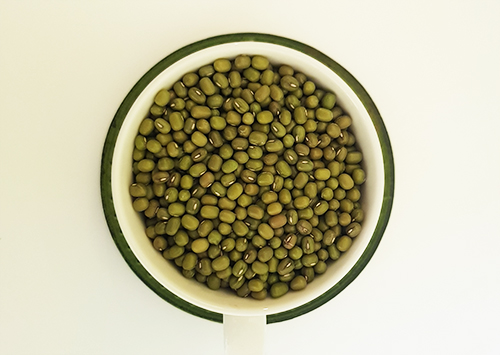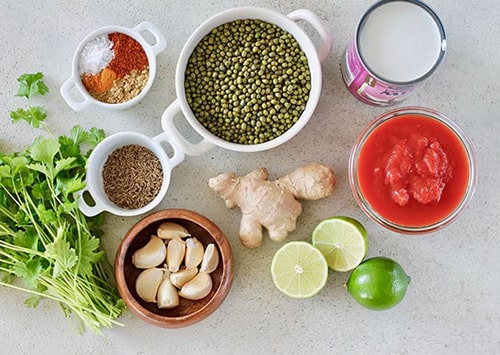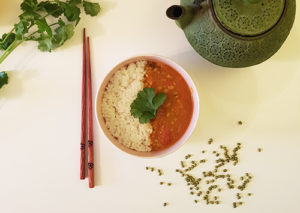
Mung what? “Monk” beans? Mung beans! It’s probably the first time you hear that sound in your mouth. Though, I’m sure you passed by them the last time you went into an organic or in a bulk shop. These beans are becoming more popular in the plant-based scene because they have a high level of protein and they are incredibly rich-nutrients. Here’s why you should put that overlooked food into your meals and how to cook it.
What are Mung Beans?

Mung beans are tiny green seeds belonging to the legume family. Before the plant is being shelled, it looks similar to haricots. Originally from India, they have been cultivated since ancient times throughout various parts of Asia.
Approved by Ayurvedic cuisine, once these dry-beans are cooked, the taste is slightly sweet and the texture becomes very soft. Mixed with ginger, curry, or coriander, and it’s a blast of flavors in your mouth!
Are you a sprouts lover? You probably ate them without even knowing. Sprouts sold in the grocery store are generally either Mung beans sprouts or soybean sprouts. They’re delicious in a salad or as a side dish!
Mung Beans health benefits
Mung beans’ reputation broke out after their healthy nutrients came to light. Extremely nutritious, these seeds are the perfect staples to switch to a plant-based diet.
It’s one of the best plant-based sources of protein!
Additionally, they’re packed with fiber, magnesium, iron, folate, and vitamin B6. This nutrient bundle reduces chronic disease risk, cuts down “LDL” cholesterol, and help for digestive health.
You know what? Sprouting them brings even better nutritional benefits! Sprouted beans contain fewer calories, more antioxidants, and tons of healthy fibers!
Where to buy Mung Beans?
The dried-beans version can be found packaged in health food stores or in Asian shops. However, the most eco-friendly way is to get them without packaging in bulk stores. Regarding sprouts, it’s very easy to germinate them at home. Yet, they’re also sold in any supermarket.
How can I eat Mung Beans?
Excited to put them in your everyday meals? Mung beans are diverse and can be eaten as the whole bean, mashed, or even in the sprouted form. You can add them to salads, soups, curries, or sauces. Chinese even use mung beans to make a sweet dessert called tángshuǐ.
My favorite vegan recipe is a tomato-based stew with coconut and curry. I love it! I cook it at least 4 times per month.
Above all, it’s super easy to prepare! I usually cook one big pot and I eat it for 2 or 3 extra lunch/dinner. Each day I alternate the starches with rice or noodles. Let’s cook this together!

Recipe's specifics
Time: 50-minutes
Difficulty: Easy
Price: Cheap
Tasty with or without Coriander
Ingredients for 6 portions
⌀ = Ingredient easy to find without packaging.
Ingredients
- 1 cup of soaked mung beans ⌀
- 4 cups of boiled water ⌀
- 250ml of crushed tomatoes
- 2 tomatoes ⌀
- 250ml of coconut milk
- 2 tbsp of grated ginger ⌀
- 1 tbsp of cumin seeds ⌀
- 1 onion ⌀
- 9 cloves of garlic ⌀
- 1 tsp of curcuma ⌀
- 1 tsp of cumin ⌀
- 1 tsp of spicy powder (hot paprika or cayenne pepper) ⌀
- 1 lime juice ⌀
- Olive oil ⌀
- Salt & pepper ⌀
Utensils
- 1 Blender
- 1 Sieve
- 1 Bottle of 1 liter
Recipe step-by-step
- Chop the onions and cook them in oil over low heat.
- Add cumin seeds, cumin powder, Curcuma, and garlic until onions are translucent.
- Chop the tomatoes and add them in the pot with the crushed tomatoes.
- Add the grated ginger and hot spices.
- Increase the heat to medium and keep cooking the mixture for 5 minutes.
- Add the boiled water, the Mung Beans, and bring the mixture to boil. Then decrease to low and simmer for 30 minutes.
- Taste the Mung Beans to make sure they are cooked. If they are, add the coconut milk and keep cooking for 10 more minutes.
- Add the lime juice and taste the curry. Adjust the seasoning with salt and pepper if necessary.
- Serve as a soup, with rice or noodles.
- Enjoy the Indian flavors!

